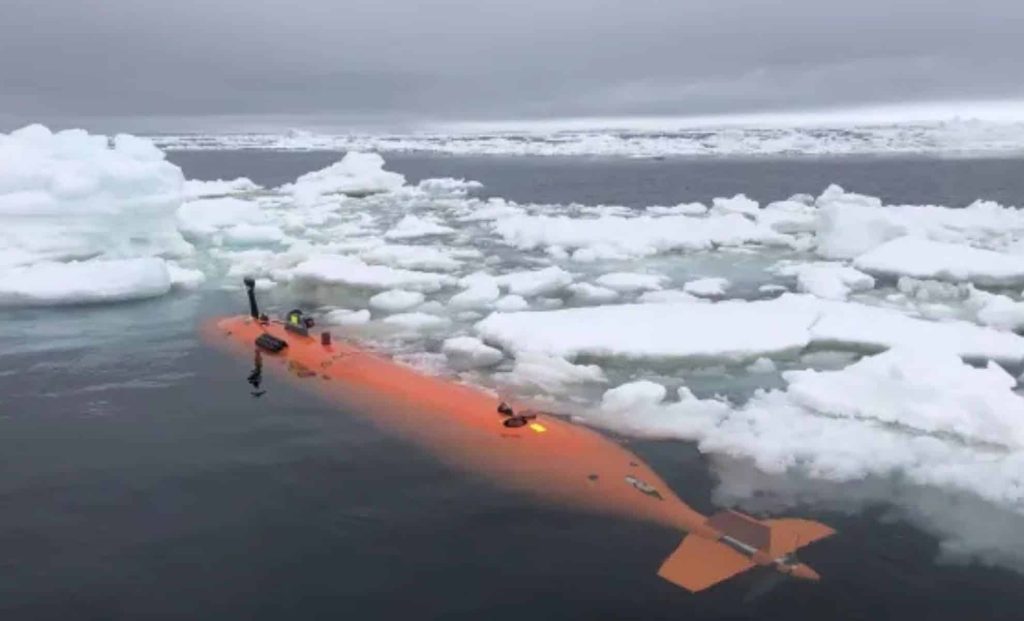Submersible Sent to Explore Antarctica’s ‘Doomsday Glacier’ Mysteriously Disappears – Indian Defence Review

A high-tech submersible has mysteriously vanished beneath Antarctica’s most dangerous glacier, leaving scientists baffled and concerned. The robotic vehicle, designed to explore the unstable Thwaites Glacier, failed to return from its second dive, despite having an advanced navigation system. With its signal lost and batteries presumed dead, researchers now fear it may be gone forever, trapped under the ice. A seven-meter-long robotic submersible, designed to explore one of the most unstable and dangerous glaciers in Antarctica, has vanished without a trace. The autonomous vehicle, named Ran, was conducting its second deep dive beneath Thwaites Glacier, ominously nicknamed the ‘Doomsday Glacier’, when it failed to return. Despite advanced navigation systems programmed to guide it back to open water, the sub’s signal was lost, leaving researchers with no explanation for its disappearance.The mission, led by a team from the University of Gothenburg, aimed to uncover the mysteries hidden beneath Thwaites, a glacier so critical that its collapse could raise global sea levels by several meters. Now, the scientists face not only the loss of groundbreaking data but also the reality that their pioneering sub may be lost forever beneath the ice.The Thwaites Glacier, located on the northern edge of the West Antarctic Ice Sheet, is one of the most studied and feared glaciers on Earth. If it were to fully melt, it could contribute to a catastrophic rise in sea levels, reshaping coastlines and displacing millions of people worldwide. Ran, an autonomous underwater vehicle (AUV), was deployed to map the glacier’s underbelly, providing an unprecedented look at how warm ocean waters are eroding it from below.On its first dive, Ran successfully returned, delivering invaluable data that helped researchers understand how the glacier is breaking apart. However, during its second mission, something went terribly wrong. The sub was supposed to navigate back to its rendezvous point, using a pre-programmed route and advanced sonar guidance, but it never reappeared.“It’s a bit like looking for a needle in a haystack, but without even knowing where the haystack is,” said Professor Anna Wåhlin, a lead scientist on the project.With Ran’s batteries now presumed dead, any hope of recovering it grows dimmer by the day. The team suspects that the sub ran into unexpected trouble, possibly getting trapped under thick ice or crashing into an unseen obstacle. The harsh environment beneath Thwaites is unforgiving, with towering ice walls, powerful currents, and unpredictable meltwater channels that could have led the sub into a dead-end beneath the glacier.While the loss of Ran is a major blow to the mission, researchers acknowledge that this was always a risk. The extreme conditions under Thwaites Glacier make it one of the most challenging places on Earth to explore, and even the most advanced robotic submersibles are vulnerable to the unpredictable forces of nature.Despite its tragic fate, Ran’s previous missions had already provided critical data that offered scientists a rare look at the melting process beneath Thwaites. Unlike satellite imagery, which can only observe changes at the glacier’s surface, Ran was able to navigate deep beneath the ice, gathering first-hand evidence of how warm ocean currents are accelerating its retreat.“Thanks to Ran, we became the first researchers in the world to enter Thwaites in 2019, and during the current expedition we have visited the same area again,” Professor Wåhlin explained.Even in its final dive, Ran was operating at the frontline of climate science, pushing the limits of technology to understand one of the greatest environmental threats of our time. However, the loss of the sub raises an important question—is it worth risking millions of dollars in high-tech equipment to explore such treacherous environments?Dubbed the ‘Doomsday Glacier’, Thwaites is considered one of the most vulnerable and dangerous glaciers on the planet. Spanning roughly 120 kilometers (75 miles) wide, it acts as a natural barrier, preventing the entire West Antarctic Ice Sheet from rapidly collapsing into the ocean. If Thwaites were to fully melt, global sea levels could rise by over three meters (10 feet)—enough to submerge major coastal cities like New York, London, and Shanghai.What makes Thwaites particularly dangerous is that it is melting from below. Warmer ocean waters are undercutting the glacier, eating away at its foundation and causing massive ice chunks to break off into the sea. This process is happening much faster than expected, raising concerns that Thwaites could reach a tipping point where collapse becomes inevitable.The data collected by Ran before its disappearance was crucial in understanding this hidden battle beneath the ice, offering rare insights into how warm currents interact with the glacier’s structure. However, the loss of the sub leaves critical questions unanswered, and the race to study Thwaites before it’s too late is now more urgent than ever.Despite the devastating loss of Ran, the team remains committed to continuing their research. However, replacing a state-of-the-art submersible comes at a steep price, and additional funding will be needed to develop a new robotic vehicle capable of withstanding Thwaites’ harsh conditions.“The data we receive from Ran is unique in the world, and of great value for international research,” Wåhlin emphasized.But with each passing year, Thwaites Glacier continues to weaken, meaning time is running out for researchers hoping to gather more information before a major collapse occurs. While losing Ran is a setback, it has reinforced the high stakes involved in studying one of Earth’s most dangerous glaciers.As scientists push forward, they hope that future expeditions will not only recover lost data but also unlock new ways to combat climate change and predict the fate of our planet’s frozen frontiers.Got a reaction? Share your thoughts in the commentsEnjoyed this article? Subscribe to our free Newsletter for engaging stories, exclusive content, and the latest newsHi. Interesting. If you do build another sub it may be a good idea to attach a cable to follow it and bring it back. Is it too dangerous to send a small one man sub down? Thank you Dawn.Fully melt? That would mean that the Earth has fully tilted so that the South Pole would be where the Equator used to be. That problem would create big problems quicker.Comment Save my name, email, and website in this browser for the next time I comment.
© 2024 | Indian Defence Review | All rights reserved
Source: https://indiandefencereview.com/submersible-antarcticas-glacier-disappears/



